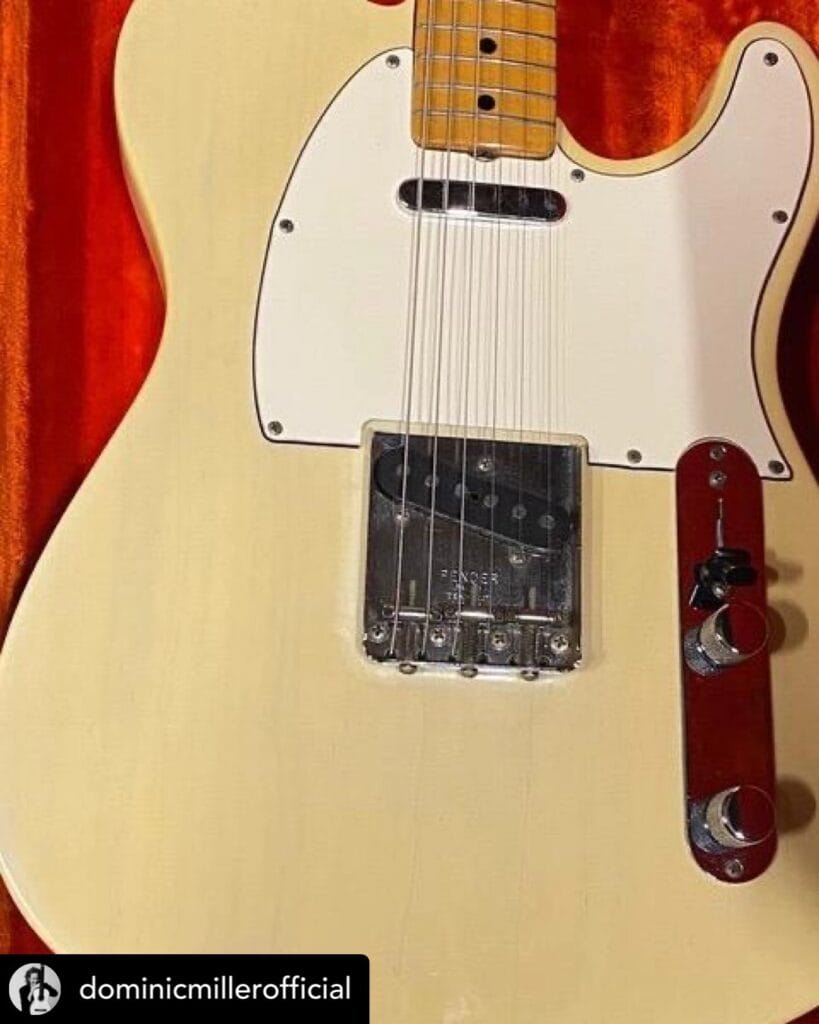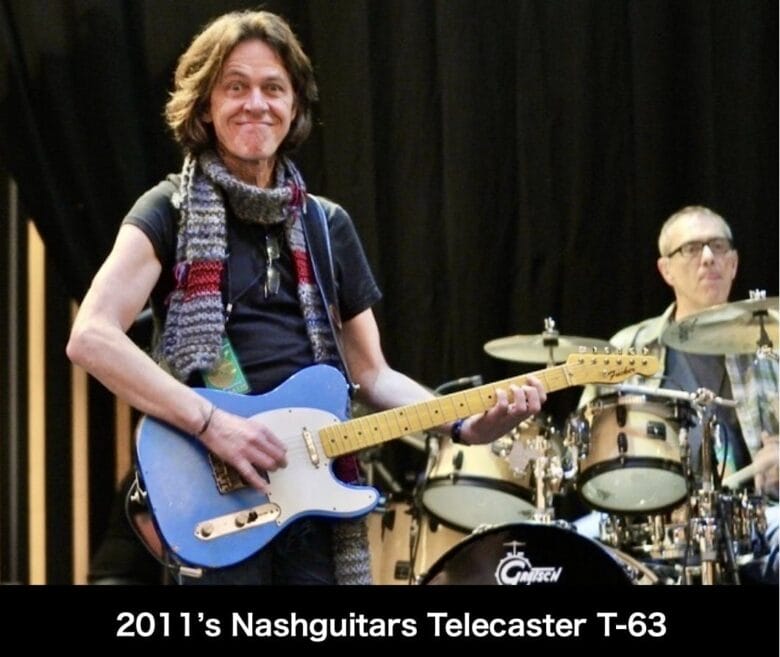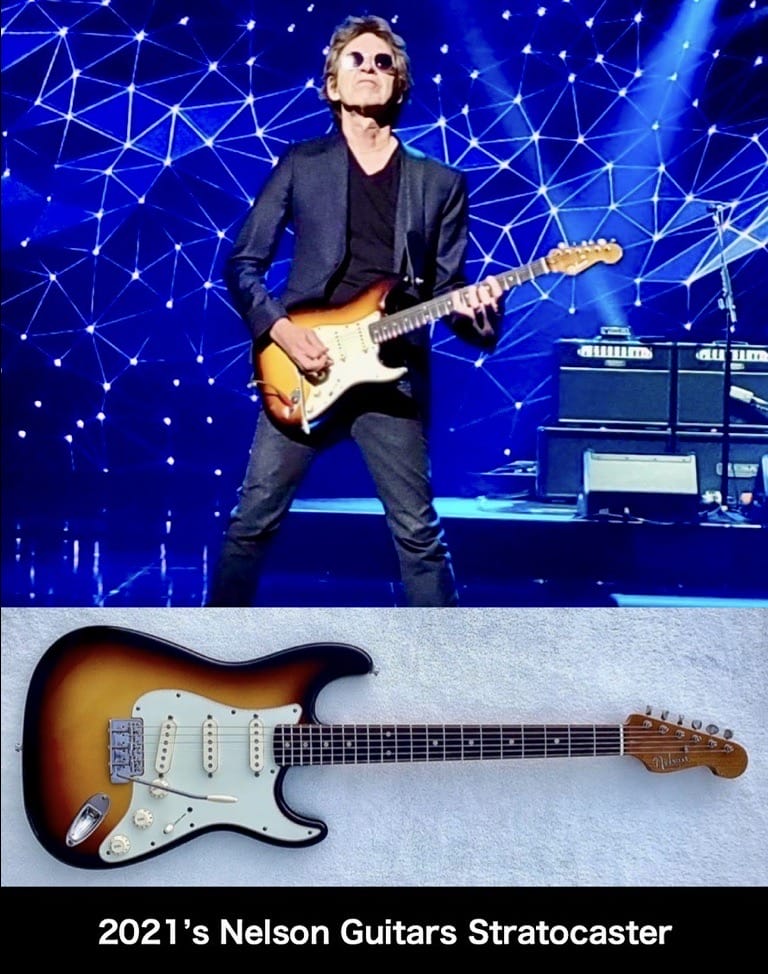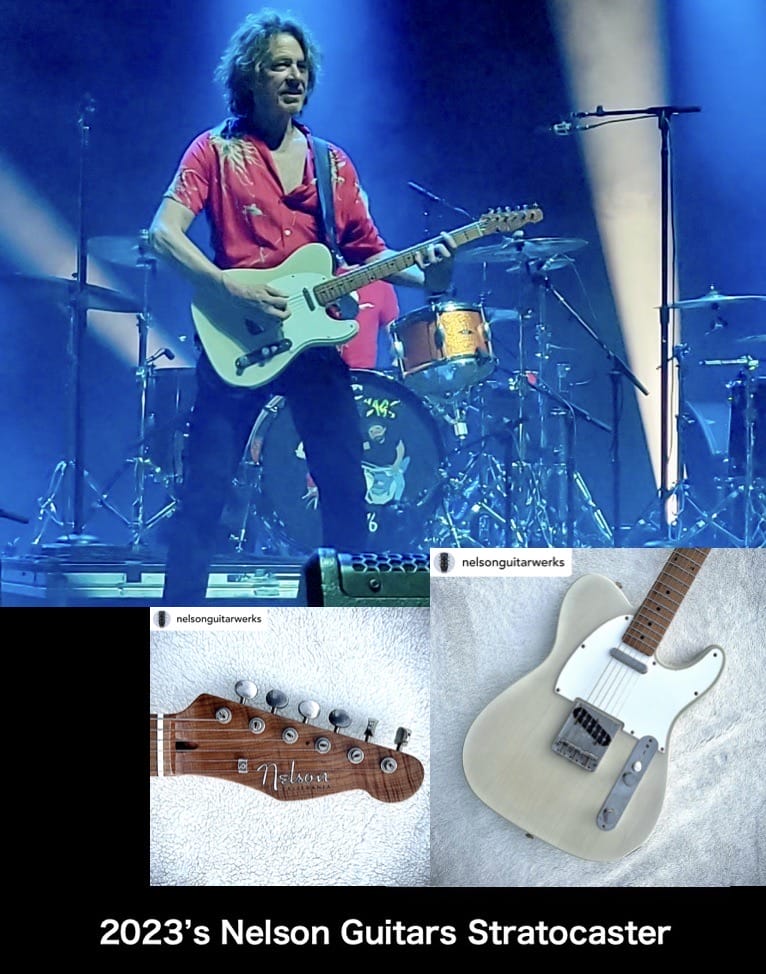1968 Fender Telecaster
【SPEC】
・色:Butterscotch Blonde(バタースコッチ・ブロンド)
・ネック材:メイプル
・指板材:メイプル
・ボディ材:アッシュ
・ピックアップ:オリジナル
・弦ゲージ:不明。ダダリオの弦が張ってあるようだ。
・塗装:ポリ塗装 + ニトロセルロースラッカー
1968年に作られたオール・オリジナルのヴィンテージ・テレキャスターですが、新品同様に非常に美しく保たれた、ミントコンディションのものです。ボディ素材はアッシュ。また、このギターのネックはメープルの材の上にメープルの指板を貼り付けているが、これはこの年代では珍しい仕様のギターだ。ドミニクは長い間メープルネックの良いギターを探していたようだ。
元々フェンダーのテレキャスターのネックは58年まではメープルの無垢材だった。しかし、59年からはメイプル材のネックの上にローズウッドの指板を貼るようになった。そして60年台前半からたまにローズウッドではなくメイプル材を貼ったのものが作られていた。その後、69年後期から再びメープル無垢材のネックが標準仕様になった。だから68年のギターのはローズウッドの指板が標準仕様だったので、ドミニクのこのギターは同じ68年生産のギターの中では珍しいものということになる。
塗料は1967年からだんだんポリ塗装のみに変わっていったのだが、68年前半はまだポリ塗装の一番上にはニトロセルロースラッカーが吹かれていたようです。68年の後期にはこの上のラッカー塗装はオプション扱いになった。
「良い楽器ほどすぐに良い音を出すのは難しい」
このギターについてドミニクはかつてこのように語っていました。
【メイプル・ネックのギターがずっと欲しくて、やっとみつけたんだ。今までギターに使った中で一番高い買い物でした。
これは手なずける必要のある野生動物のようだ。でもそれが彼らの好きなところです。とても個性的だけど、すべてがうまく機能しています。このギターのネックとボディのバランスが大好きで、ストラトよりもあらゆる倍音を拾ってくれる感じがします。私はずっとストラト派でしたが、長い間Bill Nashのテレキャスターを使っていたので、理由はわからないけどテレキャスターを弾きたくなったんです。これはとても高価だったのですが、でも『自分へのご褒美に本物を買ってみようか 』と思ったんです。
初めて弾いたときは、ビル・ナッシュのテレほど良くないと思いました。でも6か月後には、実際、最初より10倍は良くなりました。このギターの弾き方を学んだからだと思います。すぐに音は出てきませんでした。自分で見つけなければなりませんでした。私は楽器が良ければ良いほど、すぐに良い音を出すのは難しいと思います。】
I always wanted to have one with a maple neck and I found one – that’s the most money I’ve ever spent on guitar, for sure. It’s like a wild animal that you need to tame.
That’s what I like about them, they have so much character. Everything works well together. I love the balance of the neck and the body; it seems to pick up all kinds of overtones from everywhere, more than a Strat does. I don’t know why because I’ve always been a Strat kind of guy; I just wanted to play a Tele because I’ve been using Bill Nash Teles for a long time now.
But then I thought, ‘Why don’t I treat myself to a real one?’ When I first picked it up, I thought it’s not as good as the Nash, but then cut to six months later and it’s actually 10 times better, I think, because I’ve learned how to play it. The sound didn’t come to me immediately. I had to find it. I think the better the instrument, the harder it is to make it sound good immediately.
https://www.guitarworld.com/features/dominic-miller-sting-bought-and-sold
私はいつも思いますが、ドミニクのこのような「音」に対しての考え方が本当に大好きです。
ドミニクのギターの使い分けについて
1961年製のストラトキャスターの記事のところにも書きましたが、ドミニクはギターを沢山持って移動したくないので、世界各地にギターを分散して保管しています。今まで色んな「事件」がありましたからねー。ロストバゲージ(ブルーのテレ)、ネック折れ(白のレスポール)、税関止めでスタジオに届かず(アルバム『Silent Light』録音時)とか。だからギターを出来るだけ移動させたくないドミニクの気持ちもよく分かります。なので、スティングのツアーの時に使用するドミニクのギターは基本的にこのような使い分けがされています。
・Aリグ(ヨーロッパ用)= 61年ストラト(メイン) + ブルー・ナッシュ・テレ
・Bリグ(アメリカ・アジア用)= 68年ブロンド・テレ (メイン) + ネルソン・ストラト、レッド・ナッシュ・テレ、ネルソン・テレ
だから、ヨーロッパでスティングのライブを見ると、ドミニクはメインギターとして61年のストラトを持っているし、アメリカや日本含めたアジアでは、彼はこの68年製のテレキャスターを使用しています。
A リグ(ヨーロッパ用)
B リグ(アメリカ・アジア用)
このネルソンのギターについてはまだ詳細な情報が少ないです。カリフォルニアにあるNelson Guitarsという個人のギター工房的な所のようで、その工房のBruce Nelsonという人が製作しているとの事ですが、現在HPらしいものも見当たらない、知る人ぞ知るという感じの小さな工房のようです。ドミニクの息子であるルーファスや、エアロスミスのジョー・ペリー、ストーン・テンプル・パイロッツや、スマッシング・パンプキンズのジェイムス・イハもこのギターを使用しています。
しかし、上のストラトはレリック加工されてないので、61年製ストラトとの見分けは簡単ですが、ネルソン・テレキャスは遠目には68年製テレキャスとほとんど見分けがつかないように見える!見分け方は、68年製のテレキャスはスイッチが黒く、ボディの色が少し濃く黄色い!
裏話
私は去年くらいまでこのようなドミニクのギターの使い方の基準があまりよくわかっていなかった。どういう規則性があるのか不思議に思っていた。しかしあるヨーロッパ在住のスティングファンの男性も私と同じ疑問を持ち、数年前ドミニクにスティングのツアーで使用するギターを決める際のポイントがなんなのかを質問したそうです。すると、ドミニクはこう答えたそうです。
【女性がハンドバッグを選ぶように、僕はギターを選ぶんだ。】
つまり、あんまり深い意味はなくて、女性がその日の服装に合わせて好きなバッグを選ぶように、曲に合わせて弾きたいギターを選んでるんだよ、と。
私はこの話を聞いて「なんとドミニクらしい答えだ!」とめちゃくちゃ納得しました。基本的にドミニクは一般的なプロギタリストの中では機材にこだわりが少ないギタリストです。結局ドミニクの基本的な考え方はやはり良い音は自分自身が出せるようにするものであり、演奏者である自分自身の問題の方が大きい。だからどんなギターだろうと、彼は自分が出したい音が出るようにそのギターに合わせていくだけなんです。
ドミニクにとってはギターというのは全く特別な物じゃありません。着慣れた古いジーンズやTシャツみたいなものです。ドミニクはいつでもどこでも自分が気が向いた時にすぐにギターを弾きたい。だから、K-YairiのCYTMのような、軽くて小さくて、音も良くて持ち運びやすいパーラータイプのアコースティックギターを好んで使っています。実際、ドミニクの家ではキッチンでも普通にあのギターが転がっているらしいよ(笑)
※この記事に関しては、Mr.Akiyama、 Mr.Taniguchi(in KYOTO)、Mr.Taniguchi(in Saitama)のご協力と、Instagram@stingthegear さんから頂いたいくつかの情報を元に作成されました。
1968 Fender Telecaster
【SPEC】
・Colour:Butterscotch Blonde
・Neck:Maple
・Fingerboard:Maple
・Body:Ash
・Pickup:Original
・String gauge:Unknown.
Appears to be strung with D’Addario strings.
・Paint:Polyurethane + Nitrocellulose lacquer
A completely original vintage Telecaster from 1968 in mint condition. The body material is ash. The neck of this guitar is also made of maple with a maple fingerboard over maple, which is a rare specification for this age. Dominic has been looking for a good maple neck guitar for a long time.
Until 1958, Fender Telecasters had solid maple necks, but from 1959 onwards, maple necks were fitted with rosewood fingerboards, and from the early 1960s maple fingerboards were occasionally used instead of rosewood. Subsequently, solid maple necks became the standard specification again from late ’69. This makes Dominic’s guitar unusual among the same ’68s, as rosewood fingerboards were the standard specification for ’68s.
The paintwork was gradually changed to polyurethane from 1967, but in the first half of 1968 it appears that nitrocellulose lacquer was still sprayed on top of the polyurethane paint; in the second half of 1968 this top coat was treated as an option.
The better the instrument, the harder it is to make it sound good soon.
Dominic once said of this guitar.
“The last guitar I bought was a 1968 Fender Telecaster. I bought it in Los Angeles about six months ago. I always wanted to have one with a maple neck and I found one – that’s the most money I’ve ever spent on guitar, for sure. It’s like a wild animal that you need to tame.
That’s what I like about them, they have so much character. Everything works well together. I love the balance of the neck and the body; it seems to pick up all kinds of overtones from everywhere, more than a Strat does. I don’t know why because I’ve always been a Strat kind of guy; I just wanted to play a Tele because I’ve been using Bill Nash Teles for a long time now.
But then I thought, ‘Why don’t I treat myself to a real one?’ When I first picked it up, I thought it’s not as good as the Nash, but then cut to six months later and it’s actually 10 times better, I think, because I’ve learned how to play it. The sound didn’t come to me immediately. I had to find it. I think the better the instrument, the harder it is to make it sound good immediately.”
Guitar World
Sting guitarist Dominic Miller: “You gave Jeff Beck a tennis racket and a transistor radio, he’d mak…
It’s not the gear, it’s the player says Miller, but then, those vintage Telecasters and ES-335s sure do come in handy
https://www.guitarworld.com/features/dominic-miller-sting-bought-and-sold
I always think, and I really love this way of thinking about ‘sound’ from Dominic.
How does Dominic choose which guitars to use?
As mentioned in the 1961 Stratocaster article, Dominic doesn’t like traveling with a lot of guitars, so he has them scattered all over the world. There have certainly been many “incidents” in the past! Lost baggage (blue Tele), broken neck (white Les Paul), not reached the studio due to a customs stop (when recording Silent Light). So I understand Dominic’s reluctance to move the guitar as much as possible. For this reason, when Sting is on tour Dominic basically uses his guitar like this.
A rig (for Europe) = ’61 Strat (main) + Blue Nash Tele
B rig (for USA and Asia) = ’68 Blonde Tele (main) + Nelson Strat, Red Nash Tele, Nelson Tele
So when you see Sting live in Europe, Dominic has a ’61 Strat as his main guitar, and in the USA and Asia, including Japan, he uses this ’68 Telecaster.
A rig (for Europe)
B rig (for USA and Asia)
There is not much information about this Nelson guitar yet. It seems to have been made by Bruce Nelson of Nelson Guitars. Nelson Guitars is a private guitar workshop in California, but there is no website at the moment, so it seems to be a workshop known only to those in the know.However, the guitar has also been used by Dominic’s son Rufus, Joe Perry of Aerosmith, members of Stone Temple Pilots and James Iha of the Smashing Pumpkins.
The Strat above is easy to distinguish from a ’61 Fender Strat because it is not a relic, the Nelson Tele look almost indistinguishable from a ’68 Fender Telecaster from a distance! The way to tell them apart is that the ’68 Tele has black switches and a slightly darker yellow body colour!
The Backstory
I didn’t really understand these standards of Dominic’s use of the guitar until the last year or so. I wondered what kind of regularity there was. But one man, a Sting fan living in Europe, had the same question as me and asked Dominic a few years ago what the key points were in deciding which guitar to use on Sting’s tours. Dominic replied.
[I choose the guitar like a women chose her handbag.]
In other words, without any deeper meaning, he chooses the guitar he wants to play to the tune, just as a woman chooses her favourite bag to match her outfit for the day.
When I heard this story, I think, “What a very Dominic answer!” I was very much convinced. Basically, Dominic is a guitarist who is less concerned with equipment than other professional guitarists. After all, Dominic’s basic philosophy is that a good sound is something you produce yourself, and that you as a performer are the main problem. It’s not about the equipment. So whatever guitar he uses, he simply adapts to it to produce the sound he wants to produce.
For Dominic, a guitar is nothing special at all. It’s like an old pair of jeans or a T-shirt that you’re used to wearing. Dominic likes to play his guitar whenever and wherever he feels like it. That’s why he prefers acoustic guitars like K-Yairi’s CYTM, a light and small parlour-type guitar that sounds really good but is easy to carry around. So I heard that there is often the guitars lying around in the kitchen at Dominic’s house (lol).
※This article was prepared with the help of Mr Akiyama, Mr Taniguchi (in KYOTO), Mr Taniguchi (in Saitama) and some information from Instagram @stingthegear.


















